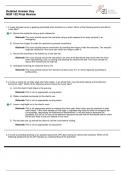Exam (elaborations)
NUR 102 Final Review | ati detailed answer key
- Course
- Institution
NUR 102 Final Review |ati detailed answer key 1. A newly licensed nurse is applying prescribed wrist restraints on a client. Which of the following actions should the nurse take? A. Secure the restraints using a quick-release tie. Rationale: The nurse should secure the restraints using a quick-...
[Show more]



